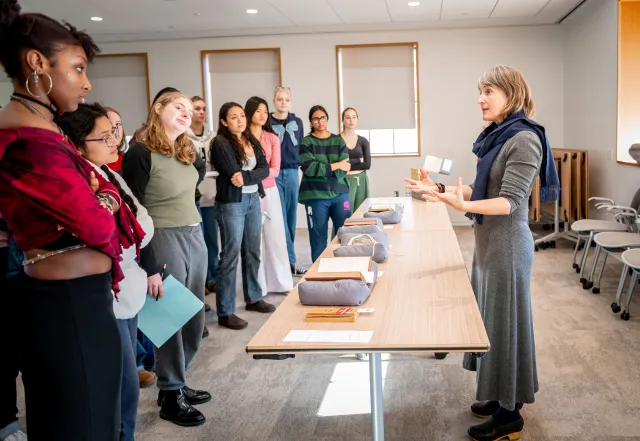Words of Nourishment from New Curator of Rare Books
News

Published November 20, 2025
Where some may see rare books as dusty old vessels for historic texts and images, Curator of Rare Books Erin McGuirl sees seeds and sprouts of modern media.
“Technology has changed so quickly, and our whole world is governed by media tools in ways that we sometimes don't understand,” she says. “The Mortimer Rare Book Collection offers students an opportunity to see how their world and the historic collection are deeply interconnected, even though they sometimes seem so different.”
These connections intersect across genres, centuries, and targeted audiences. But what if, Erin asks, there are commonalities that create relevance and community to modern readers?
“I try to show students how to see printed material as a forerunner of things that they experience every day through the computer in their pocket or their laptop. It’s relevant, timely, and important in 2025 and beyond.”

“I try to show students how to see printed material as a forerunner of things that they experience every day through the computer in their pocket or their laptop. It’s relevant, timely, and important in 2025 and beyond,” she notes.
Take, for example, a recent acquisition in the MRBC — a group of original screenplays from the film Clueless. Knowing the film is discussed in Smith’s first-year seminar “The Art of Gossip,” Erin saw an opportunity to explore Clueless’s relevance to both the student experience and the text from which the screenplay was adapted.
“Professor Melissa Parrish asks her first year seminar students to explore what gossip is and does, to look beyond our assumptions,” Erin says. “With Clueless, writer-director Amy Heckerling makes you a participant in the gossip through [main character] Cher's voiceover narration speaking to you, the person who's watching the movie, about her friends and her life.”
Looking at the screenplay, Erin notes the scriptwriter makes it clear that all of Cher’s dialogue spoken to the audience is parsed out in an intentionally-situated way on the page. “It’s exciting to get students thinking about how a printed text actually becomes a whole new form of media, and the relationships between those two — the screenplay and the final movie.”
Formatting aside, Erin says the adaptation of Clueless itself is fascinating as well — and not many realize its plot is lifted directly from Jane Austen’s Emma. “If you looked at the first edition of Emma and then looked at a screenplay for Clueless, you wouldn't think that these two things had anything to say to each other,” she says. “I show students how deeply enmeshed all of this stuff is, and the kinds of conversations that can happen across print culture—and I want it to be fun.”

Erin has always had an eye for details.“I studied art history as an undergraduate, and I was always interested in close reading and material culture,” she says. While at Columbia, getting a job at the Avery Library ignited something within her and helped put a potential career path into focus. “The Avery Library is one of the best art and architecture collections in the world, and I knew I wanted to be a curator from the moment I started,” she recalls. “It was so obvious to me at the time, and I felt fortunate that I found a career path when I was still so young.”
Erin went on to get a degree in library science, and later began studying the hidden labor of secretaries in Hollywood and American offices reliant on editorial and typist work. She continued working in various libraries in New York and with private collectors, an experience she notes was a particularly educational facet of her career. “It helped me get to know the nuts and bolts of the book trade and build relationships with booksellers, and that has been really important to me,” she says. “A crucial element of curatorial work is building personal relationships with people and keeping ahead of the most obvious trends in the field.”
Just before arriving at Smith, Erin worked for the Bibliographical Society of America. “Bibliography is actually about media literacy,” she says. “Bibliography asks us to think about why books look the way that they do, and how to be a historically informed reader.”
Watching the organization grow and diversify, she says, felt especially meaningful. “I'm proud of the work we did to expand our peer-reviewed journal’s coverage and bring new voices to the field,” she notes. “That is something I feel is part of what Smith College Special Collections is doing, and I'm excited about participating in that kind of work.”
Erin began her role at Smith in July of 2025, though she was no stranger to the MRBC’s namesake. “Coming from an art history and architecture background, I’ve always admired the work of Ruth Mortimer,” she says. “I had known who Ruth was from the earliest moments of my career, because she had built a way to address illustrated books. Being in this collection on which her stamp is so strong means a lot to me, personally.”
Delving deep into the MRBC has led Erin to some moving and meaningful findings, and she looks forward to future discoveries. “There’s been exciting surprises, like the Hampshire Bookshop and Holiday Bookshop records,” she notes. “These places, especially for queer communities, are bookstores where people in marginalized spaces have historically found safety and togetherness, and they were able to connect through the books they loved.”
That safety, she says, is something that travels off the pages of collection materials and into the minds and bodies of those who visit Special Collections. “One of the best-known strengths of the MRBC is literature and poetry. In troubling times, people turn to art and literature that inspires them to connect with other people, to grieve and find an articulation for their grief, to express their hopes, or simply to rest,” she says. “The Reading Room is an incredible space on campus where you can sit down and all of the noise is gone. You can just focus on nourishing yourself with the words of the people, pictures, or great book art by the folks who you connect with as artists and thinkers.”
Check out the Smith College Special Collections website to learn more about the Mortimer Rare Book Collection, or plan a visit to the Reading Room to view our materials!